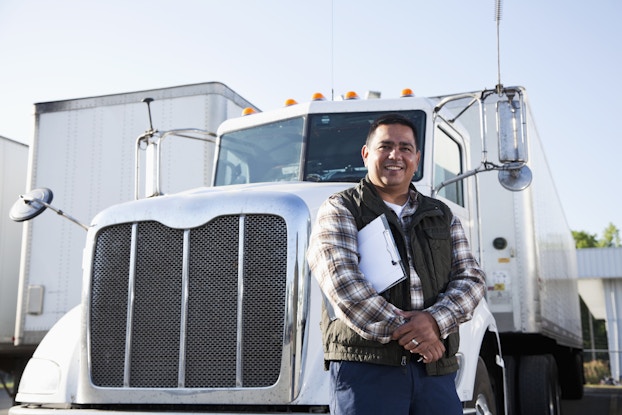
Did you know that in the United States, 80% of all cargo is transported by the trucking industry? The industry hit its peak of $800 billion in 2018 and is projected to grow by 75% by 2026. Here are seven steps to starting a profitable trucking company.
Apply for your CDL
The first step is to apply for your commercial driver’s license (CDL). A CDL is a special driver’s license required to operate large and potentially hazardous equipment for commercial purposes.
The specific requirements for receiving your CDL will vary depending on the state you live in. But you’ll need to provide your personal identification, submit a medical examination report and pass a vision test.


Once you’ve passed the test and paid any associated fees, you’ll receive a Commercial Learner’s Permit (CDP). After 14 days, you can schedule your CDL road skills examination.
Outline your startup costs
If you’re planning to start a small trucking business, you can expect to spend between $10,000 and $20,000 on startup costs. This includes the following costs:
- Registration fees.
- Insurance costs.
- The price to buy or lease the vehicles.
- State-specific permits and expenses.
You can pay these expenses out of pocket or apply for small business funding. For instance, a small business loan or small business line of credit can help you cover these costs and boost your cash flow in the early days of building your business.
[Read more: Startups on How They Landed Millions in Funding]
Review the rules and regulations
Depending on where you live and how you plan to operate your trucking company, there are likely a number of licenses and permits required to run your business. Here are just a few of the rules you’ll need to comply with:
- USDOT number: All companies that operate commercial vehicles must register with the Federal Motor Carrier Safety Administration (FMCSA) and apply for a USDOT number. This number makes it easy for the FMCSA to monitor your company’s safety information in the event of an audit, inspection or investigation.
- MC number: Your MC number is what allows you to transport passengers in interstate commerce. The type of Operating Authority required will depend on the FMCSA’s requirements. Unlike your USDOT number, you may need to obtain multiple permits.
- Heavy vehicles tax: The heavy vehicles tax is a fee you’ll pay to operate heavy vehicles on public highways. If your vehicle weighs 55,000 to 75,000 pounds, you’ll pay a fee of $100. If it’s over 75,000 pounds, the fee is $550.
If you’re planning to start a small trucking business, you can expect to spend between $10,000 and $20,000 on startup costs.
Purchase the necessary equipment
Obtaining the right equipment is crucial to the success of your trucking company. It may be worthwhile to pay more money for newer trucks so you’ll have fewer maintenance and repair costs down the road.
When you’re considering trucks to buy, watch out for any rust and apparent signs of body damage. You should also pay close attention to the mileage and the vehicle’s maintenance history.
You’ll also need to decide whether you want to lease the equipment or buy it outright. Leasing can be a more affordable option if you’re short on funds and can give you some much-needed flexibility in the beginning.
Apply for insurance
Before you can receive many of the permits and licenses you’ll need to operate your business, the FMCSA requires that you take out public liability insurance. This insurance must cover both bodily injury and property damage. You can check out the insurance requirements on the FMCSA’s website.
Keep careful records
Running a successful trucking company can be challenging, but the right software and tools make it easier. The right fleet management software can help you track driver information, reduce accidents and fatalities and monitor your total mileage per vehicle.
Things can change quickly in the trucking industry, so staying on top of your numbers will help you adapt quickly. This will maximize your business’s chances of success.
[Read more: 10 Fleet Management Tools for Small Business]
Focus on hiring good drivers
According to the American Trucking Association, the turnover rate on drivers is fairly high. Even for smaller fleets, the average churn rate is 73%. So hiring and retaining quality drivers should be a top priority. Take some time to develop a strategy for how you’ll recruit new drivers, keep them happy and retain them for the long haul.
[Read more: Step-by-step Guide to Starting a New Business]
CO— aims to bring you inspiration from leading respected experts. However, before making any business decision, you should consult a professional who can advise you based on your individual situation.
Follow us on Instagram for more expert tips & business owners stories.
CO—is committed to helping you start, run and grow your small business. Learn more about the benefits of small business membership in the U.S. Chamber of Commerce, here.







